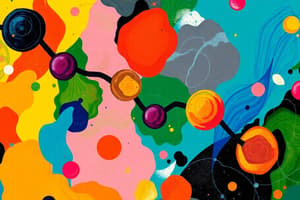Podcast
Questions and Answers
Which process involves the conversion of drugs into more water-soluble metabolites to facilitate elimination from the body?
Which process involves the conversion of drugs into more water-soluble metabolites to facilitate elimination from the body?
- Partition Coefficient
- Ionization
- Phase II drug metabolism (correct)
- Chelation
What chemical property determines how readily a drug can cross biological membranes and enter cells?
What chemical property determines how readily a drug can cross biological membranes and enter cells?
- Chelation
- Protein binding
- Optical isomerism
- Partition Coefficient (correct)
Which factor plays a crucial role in the binding of drugs to plasma proteins and tissues, affecting their distribution in the body?
Which factor plays a crucial role in the binding of drugs to plasma proteins and tissues, affecting their distribution in the body?
- Chelation
- Ionization
- Protein binding (correct)
- Optical isomerism
Which type of isomerism occurs when two molecules have the same molecular formula but differ in the spatial arrangement of atoms?
Which type of isomerism occurs when two molecules have the same molecular formula but differ in the spatial arrangement of atoms?
What term refers to the process of altering the structure of a drug molecule to optimize its pharmacological properties or reduce toxicity?
What term refers to the process of altering the structure of a drug molecule to optimize its pharmacological properties or reduce toxicity?
Which of the following processes is responsible for the initial metabolic transformation of drugs, often involving oxidation, reduction, or hydrolysis reactions?
Which of the following processes is responsible for the initial metabolic transformation of drugs, often involving oxidation, reduction, or hydrolysis reactions?
What is the term used to describe the process of replacing certain atoms or groups in a drug molecule with different but isosteric substituents to improve its pharmacological properties?
What is the term used to describe the process of replacing certain atoms or groups in a drug molecule with different but isosteric substituents to improve its pharmacological properties?
Which property is a measure of a drug's ability to distribute between lipid and aqueous environments, and is often used to predict its ability to cross cell membranes?
Which property is a measure of a drug's ability to distribute between lipid and aqueous environments, and is often used to predict its ability to cross cell membranes?
Which type of intermolecular force plays a crucial role in the binding of drugs to proteins, influencing their distribution and elimination from the body?
Which type of intermolecular force plays a crucial role in the binding of drugs to proteins, influencing their distribution and elimination from the body?
What term describes the formation of stable, cyclic complexes between a metal ion and a drug molecule, which can affect the drug's pharmacokinetic properties and distribution in the body?
What term describes the formation of stable, cyclic complexes between a metal ion and a drug molecule, which can affect the drug's pharmacokinetic properties and distribution in the body?
Flashcards are hidden until you start studying
Study Notes
Drug Metabolism and Interactions
- Ionization: affects drug absorption, distribution, and elimination, as it alters the drug's ability to cross biological membranes and interact with other molecules.
Physicochemical Properties
- Solubility: influences drug absorption, distribution, and bioavailability, as it determines the rate and extent of dissolution in various bodily fluids.
- Partition Coefficient: measures the drug's ability to partition between lipophilic and hydrophilic environments, affecting its absorption, distribution, and elimination.
Molecular Interactions
- Hydrogen Bonding: plays a crucial role in the interactions between drugs and biological molecules, influencing drug absorption, distribution, and binding to proteins and other molecules.
- Protein Binding: affects drug distribution, metabolism, and elimination, as bound drugs are not available for pharmacological action.
- Chelation: the formation of complexes between a metal ion and a drug, which can influence drug absorption, distribution, and metabolism.
Isomerism and Bioisosterism
- Optical Isomerism: the existence of non-superimposable mirror images of a drug, which can affect its pharmacological and pharmacokinetic properties.
- Geometrical Isomerism: the existence of cis-trans isomers of a drug, which can influence its pharmacological and pharmacokinetic properties.
- Bioisosterism: the replacement of a functional group with a similar group, which can affect the drug's pharmacological and pharmacokinetic properties.
Drug Metabolism Principles
- Phase I: involves the biotransformation of a drug through oxidation, reduction, or hydrolysis reactions, resulting in a more polar metabolite.
- Phase II: involves the conjugation of a drug or its metabolite with a endogenous molecule, such as glucuronic acid, sulfate, or amino acids, resulting in a more polar and excretable metabolite.
Factors Affecting Drug Metabolism
- Stereochemical Aspects: the three-dimensional arrangement of atoms in a drug molecule, which can influence its pharmacological and pharmacokinetic properties, including metabolism.
Studying That Suits You
Use AI to generate personalized quizzes and flashcards to suit your learning preferences.





